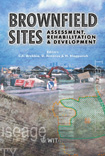Surfactant-enhanced Desorption For Recalcitrant Hydrocarbons Contaminated Soils
Price
Free (open access)
Transaction
Volume
55
Pages
Published
2002
Size
480 kb
Paper DOI
10.2495/BF020431
Copyright
WIT Press
Author(s)
H. S. Yoon & J. B. Park
Abstract
Surfactant-enhanced desorption for recalcitrant hydrocarbons contaminated soils H.S. Yoon & J.B. Park School of Civil, Urban and Geosystem Engineering, Seoul National University, Korea. Abstract Hazardous substances produced from industrial sectors have caused serious environmental problems and threatened ecological systems dating back to early 1960’s in Korea. More than 70% of the domestic wastes are disposed to landfills in Korea; however, a number of abandoned landfills and dump sites are poorly managed and are leaking leachate, which are contaminating surrounding soils and groundwater. This study focuses on the feasibility of recovery of the organic- contaminated Nanji-Do soil by applying surfactant-enhanced desorption technique. Nanji-Do landfill is the MSW (municipa1 solid waste) dump site under service in Seoul between 1978 and 1992. Surfactant-enhanced desorption technique was studied with nonionic surfactant (Triton X-100) and anionic surfactant (SDS) as desorbing solvents for extracting p-Cresol sorbed on soil particles. Sorption characteristics of soil and organic compound were analyzed and the applications of surfactant solution were studied through batch tests and the flexible-wall permeameter tests. The test results show that the surfactant-enhanced subsurface remediation technique can be adequately applicable when the contaminants are hydrophobic and recalcitrant in nature. 1 Introduction Soils and groundwater exposed to the variety of chemicals and wastes are frequently and heavily contaminated and difficult to be treated and recovered back to normal conditions. This paper focuses on the remediation of the organic-contaminated subsurface by applying the surfactant-enhanced desorption technique. Research
Keywords




